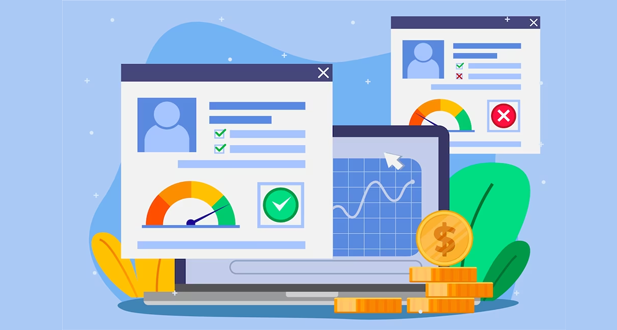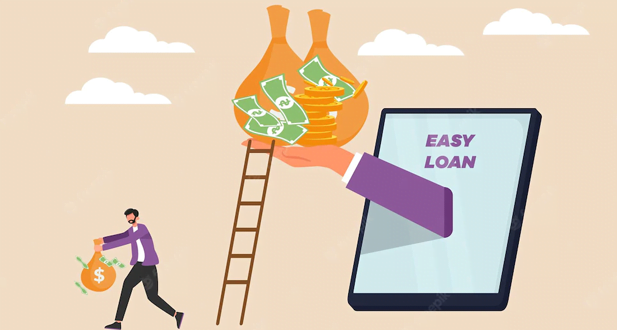Introduction
When a criminal fraudulently obtains a loan using your personal information, this is known as loan fraud.
A fraudster might, for instance, open a mortgage in your name (or obtain a reverse mortgage and steal your home equity) and then leave you to pay it off.
It is thought of as a sort of identity theft because loan fraud necessitates the stealing and exploitation of your personal information. Loan or lease fraud ranked as the fourth most frequent identity theft in 2020.
Your personal information may be obtained by scammers in a variety of ways. To obtain your personally identifiable information (PII), they can use phishing scams, or they might persuade you to download malware that gives them access to your device. however, given the prevalence of data breaches In recent years, purchasing your account details on the Dark Web has been the simplest method.
During the loaning process, many lending organizations just ask for a small quantity of information. This implies that to obtain a loan, identity thieves just require a few bits of information, such as your Social Security number (SSN) or bank account number.
At the very least, a thief might apply for several payday loans under your name. In contrast, a fraudster may open a real mortgage, business loan, or auto loan that you would be liable for repaying.
If you fall victim to loan fraud, you may be held accountable for any funds withdrawn in your name. If you don’t pay back the loan, you risk having a significant negative impact on your credit score and perhaps facing criminal charges.
You can be penalized for late payments on your credit report, for instance, if a con artist takes out a loan in your name and never pays it off. Your FICO® Score is based in part on your payment history (35%).
Sometimes it can be challenging to find loan fraud. especially if the con artist is operating out of another state or obtained access to your mail through a change-of-address scheme.
The cost of identity theft may be high. Someone could use your credentials fraudulently to open a bank account and defraud others. Scammers might obtain a loan in your name, which would harm your credit score. Even a SIM card can be purchased and used improperly. It will be up to you to demonstrate that you were a victim of identity theft after they are finished.
Usually, the identity document information is changed by fraudsters. They might alter the photographs, the address, etc. They can then apply for a loan or open a bank account using their Aadhaar, PAN Card, or driver’s license. Most document authentication services just authenticate the name and document number.
A platform for fraud management and consumer protection has just been launched by the Department of Telecommunications (DoT) (tafcop.dgtelecom.gov.in). You need to enter your mobile number on this portal. You will be aware of other phone numbers that are registered in your name based on it.
By submitting a request to the DoT, you can block any unauthorized numbers you come across. The service is not yet accessible throughout the entire nation. It is getting more DoT.
Checking your credit report frequently is another technique to keep tabs on document fraud. Look for any unusual loans or credit cards after obtaining a copy of your credit report. Additionally, the data includes email addresses and phone numbers that are on file with several lenders.
If you notice anything fishy, speak with the lender or credit card company for more information. You can let the lender or card issuer know if the loan or card is not yours. Make a police report as well.
Every year, one free credit report is provided by each credit bureau. You can check one free report from each bureau every three months because there are four of them. Profit from it.
How Identity Theft Is Used By Fraudsters To Create Mule Accounts And Ghost Loans
There is no doubt that during the past few years, the digital economy has exploded. Today, more than 80% of Indians have a bank account. This is the very reason that we can pay for nearly anything online, even your rickshaw driver or Amazon.
By allowing for new, digital means of customer onboarding, market authorities like the Reserve Bank of India (RBI) and the Securities and Exchange Board of India (SEBI) have been moving quickly to support this expansion.
On the other hand, it also implies that eventualities are plausible, such as your waking up to a loan you never applied for. These derive from the digitization of processes and, by extension, our identities. Or, more accurately, the careless handling of our identities, which gave thieves access to them and committed identity theft fraud.
When someone steals your identity and poses as you to commit a financial crime, including applying for credit or creating bank accounts, that is identity theft fraud. The most typical methods for using your stolen identities for it are listed below:
Ghost loans are loans that scammers who use stolen identities take out with no intention of repaying. Let’s look at how thieves can obtain them using your identity and stolen documents.
A standard KYC process looks for three things to confirm your credentials: proof of identity (POI), proof of address (POA), and photo identification.
Lending companies require your PAN Card as identifying evidence. We are doing this to make sure you are who you say you are. Imagine that thieves are able to obtain a copy of your PAN card. They then use powerful software programs to replace your photo on the PAN with their own.
When the verification procedure is highly manual in nature, these deceptively altered documents frequently go undetected. Similarly to this, scammers also alter the photos on documents used as evidence of address, such as your Aadhaar card or driver’s license.
To verify that the person requesting the loan and the person whose documents are being provided are the same, a photo proof is required. Fraudsters gladly upload their own photos as part of this final stage after tampering with POI and POA paperwork.
Apps that let you pay later
For KYC purposes, the majority of Buy Now Pay Later (BNPL) businesses merely demand a PAN card and a selfie. Here, fraudsters just submit the stolen PAN card as-is without altering the photo in any way. This is so that a face comparison check between the selfie and the PAN card’s photo, which serves as the only level of authentication in this case, may be made.
Fraudsters will search through your social media accounts at the moment the selfie is submitted to discover a photo that looks like a selfie. Now, some attempts may succeed if the underlying facial recognition technologies are sufficiently advanced. And with that, you’ve unknowingly opened a BNPL account in your name.
Accounting for mule
By opening bank accounts in your name, your stolen documents could be utilized in yet another way. These accounts are referred to as “mule accounts.” They frequently serve as stepping stones for the movement of money gained through illegal activity.
When was the last time you went to your neighborhood stationery to have your documents copied? There’s a good chance that their computers have copies of your sensitive information. This can be used by anyone with bad intentions to open accounts at banks using offline channels.
This kind of fraud usually takes place towards the end of the month when bank branches are already overburdened with targets to meet. Fraudsters can open a standard savings account by walking in and presenting the necessary paperwork. These documents have been altered so that the image is sufficiently fuzzy to ward off suspicion. They are able to avoid more inspections from bank workers thanks to the month-end hysteria.
An ongoing danger
As we can see, it’s quite simple for someone to steal our identity in the digital world and utilize it fraudulently. No matter how careful we are, we always leave both digital and physical footprints. It’s more important to be lucky than diligent if our identity hasn’t been compromised yet. In the end, life is really a game of chance.
Avoid Being Duped! The Best Ways To Prevent Financial Fraud
Scammers are nearly always driven by financial gain, and they are becoming more adept at duping even the most cautious individuals into disclosing their personal information. Follow these actions to help safeguard your finances and personal information from fraudsters:
Stop using credit. By putting your credit on hold, you can prevent identity thieves from opening new accounts or taking out loans in your name. To obtain a credit freeze, get in touch with all three main credit bureaus. Alternately, lock and unlock your Experian credit file instantaneously by using Aura’s one-click credit lock.
Find out how to spot phishing attacks. In emails and texts, cybercriminals will try to make you feel rushed to act and click on harmful links (for example, claiming your bank account has been compromised). Always take your time and look for scam warning signals, such as generic greetings, odd syntax, typos, and questionable links.
Check your financial statements and credit report frequently. Your financial accounts are virtually always the target of scammers. Investigate any accounts you don’t recognize or unexpected charges on your bank statement as these could be indicators of identity theft. Aura, a service that protects against identity theft, can watch over your credit report and bank statements and notify you if there is any suspicious activity.
Avoid saving your banking or credit card information with online merchants. When checking out, many online retailers need you to create an account. But data leaks and hacking can happen in these stores. Use a “guest” account instead. Although it could take a little longer, you’ll be confident that your banking information is secure.
Think about enrolling in identity theft protection. The best identity theft protection offered by Aura keeps an eye on your finances, internet accounts, and all of your most private personal information for indications of fraud. Aura can assist you in acting quickly if a scammer tries to access your accounts or finances. When you’re most exposed, use Aura’s 14-day free trial to get quick protection.
Fraudulent loans with stolen documents have become a pervasive issue, impacting individuals, financial institutions, and the economy at large. These schemes involve the illicit acquisition and use of personal identification documents to secure loans without the knowledge or consent of the rightful owner. Understanding the intricacies of this type of fraud is crucial for developing effective prevention and mitigation strategies. The following points delve into various aspects of this fraudulent activity:
1. Methods of Acquiring Stolen Documents
Fraudsters employ several tactics to obtain stolen documents, including:
- Phishing: Cybercriminals send deceptive emails or messages to trick individuals into divulging personal information, such as Social Security numbers, bank account details, and identification documents.
- Data Breaches: Large-scale breaches of corporate databases often result in the theft of personal information, which is then sold on the dark web.
- Physical Theft: Personal documents can be stolen during burglaries or pickpocketing incidents.
- Social Engineering: Fraudsters manipulate individuals into providing personal information by posing as trusted entities or through elaborate scams.
2. Types of Documents Targeted
The documents commonly targeted by fraudsters include:
- Identification Cards: Driver’s licenses, passports, and other government-issued IDs.
- Financial Records: Bank statements, credit card information, and tax documents.
- Utility Bills: Used to confirm residency and identity.
- Employment Records: Pay stubs and employment verification letters.
3. Process of Securing Fraudulent Loans
The process typically involves:
- Document Forgery: Fraudsters alter stolen documents to reflect false information that aligns with their fraudulent loan applications.
- Impersonation: Using the stolen identity, fraudsters apply for loans, often online, where verification processes may be less stringent.
- Submission of Applications: Applications are submitted to multiple financial institutions to maximize the amount of money obtained.
- Approval and Disbursement: Once approved, the loan amount is quickly withdrawn or transferred, making recovery difficult.
4. Impact on Victims
The repercussions for individuals whose identities are stolen include:
- Credit Damage: Fraudulent loans adversely affect victims’ credit scores, making it difficult to secure legitimate loans or credit in the future.
- Financial Loss: Victims may face significant financial burdens as they work to resolve the fraudulent debt.
- Emotional Distress: The stress and anxiety associated with identity theft and financial instability can have severe emotional impacts.
- Legal Complications: Victims may need to navigate complex legal processes to clear their names and recover their identities.
5. Impact on Financial Institutions
Financial institutions also suffer from these fraudulent activities:
- Financial Losses: Institutions bear the brunt of financial losses when fraudulent loans default.
- Reputational Damage: Repeated instances of fraud can erode customer trust and damage the institution’s reputation.
- Increased Operational Costs: Implementing and maintaining advanced security measures to detect and prevent fraud incurs additional costs.
6. Prevention Strategies
To combat fraudulent loans with stolen documents, several strategies can be employed:
- Enhanced Verification: Implementing multi-factor authentication and biometric verification to strengthen identity verification processes.
- Public Awareness Campaigns: Educating the public about the risks of identity theft and providing tips on safeguarding personal information.
- Regular Audits: Conducting routine audits of loan applications and approval processes to detect anomalies.
- Collaboration with Law Enforcement: Working closely with law enforcement agencies to track and apprehend fraudsters.
7. Technological Solutions
Advanced technology can play a critical role in preventing fraudulent loans:
- Artificial Intelligence (AI) and Machine Learning: Using AI to analyze patterns and detect unusual behaviors indicative of fraud.
- Blockchain Technology: Employing blockchain for secure and transparent transaction recording, making it harder to alter or forge documents.
- Real-Time Monitoring Systems: Implementing systems that monitor transactions in real-time to flag suspicious activities promptly.
8. Legal and Regulatory Measures
Governments and regulatory bodies can support fraud prevention through:
- Stricter Penalties: Imposing severe penalties for identity theft and loan fraud to deter potential fraudsters.
- Regulatory Standards: Establishing stringent regulatory standards for financial institutions to follow in their verification processes.
- Data Protection Laws: Enforcing laws that mandate robust data protection measures to prevent unauthorized access to personal information.
9. Victim Support Systems
Providing support for victims is essential in mitigating the impact of fraud:
- Credit Monitoring Services: Offering free or subsidized credit monitoring services to detect any unauthorized activities.
- Legal Aid: Providing access to legal assistance for victims to help them navigate the recovery process.
- Counseling Services: Offering psychological support to help victims cope with the emotional stress of identity theft.
Frequently Asked Questions
Scammers might obtain a loan in your name, which would harm your credit score. Even a SIM card can be purchased and used improperly. It will be up to you to demonstrate that you were a victim of identity theft after they are finished. Usually, the identity document information is changed by fraudsters.
If someone is successful in stealing your identity, they may be able to open bank accounts, apply for credit cards or loans, sign up for cell phone plans, or make purchases using your name. They might even apply for a passport or a driver’s license, which could further harm your finances and credit.
Fraudsters can go to considerable measures to pass a bank’s Know Your Customer (KYC) exams by creating false social media profiles, false identification credentials, and other fictitious documents that look to be authentic. To appear authentic, some people will even apply in person to register a new account.
Stolen personal data is used to commit identity theft.
Criminals steal this information from online accounts in order to commit identity theft, such as using the victim’s credit card or applying for loans in their name.
A person cannot be designated as a guarantor without everyone’s knowledge. Even if someone suggests another individual to act as a guarantor, that person must complete the form and provide a properly signed declaration. Additionally, a guarantee agreement on stamp paper must be signed.




